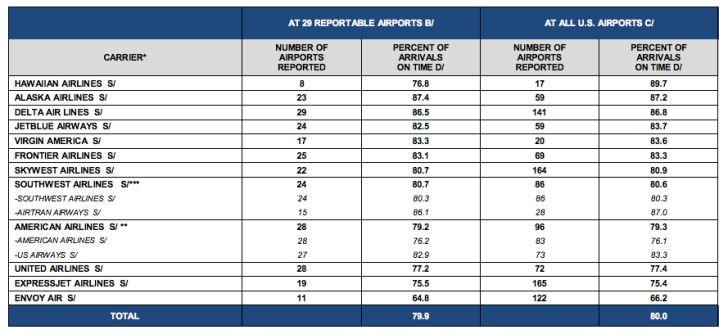Go-To Guide for Rebooking Cancelled Flights: Part 2
Last week, I started putting together a guide of behind the scenes strategy you should keep in mind if your flight gets cancelled and you have to rebook.
Here’s the second part of the series, covering other pitfalls and preferences that have served me well and which tend to be corroborated by DOT statistics and Flyertalk threads. Don’t get stuck waiting at the airport!

You thought you were flying United to Chicago, but you’re actually flying Trans States Airlines, a regional carrier (on-time arrival rate, 67% - source: flightstats.com)
(4) Be wary of getting rebooked on another carrier
Airlines have agreements with other carriers to rebook you at a predetermined rate when they can’t take you themselves.
While this works for people that absolutely have to get to their destination right this second (or those that want to claim mileage credit on both airlines), it introduces a ton of other problems that most don’t consider. Namely, your seat assignments are toast, as is lounge access (which is invaluable during irregular operations).
Good luck trying to get the new airline to waive bag fees, plus there’s a lot of room for finger-pointing if something goes wrong. I’ve seen agents literally walk over to the other desk to scream at each other when the first ticketed a reservation the second couldn’t (or didn’t want to) see. And I was trying to get on a flight departing in 30 minutes. Fun times.
Pro Tip: Be aware that if you get rebooked on another carrier, any perks of status go out the window. Weigh that carefully, since status is most useful when things go sideways. You may be trading away your ability to jump queues and access more expert or less hurried agents.
(5) Choose bigger aircraft over small, and mainline over regional
Some airports, notably SFO, often get air traffic delays caused by runway limitations. Others get air traffic control (ATC) limits imposed due to weather, construction, or other factors. When that happens, airlines typically prioritize larger hub-to-hub aircraft over regional jets in order to inconvenience the fewest people.
They’d rather anger 55 people from Omaha than 180 New Yorkers. I would too.
As a result, I’d rather be on a 757 or even an A319 over a CR7 or CR9, all else being equal.
Pro Tip: Get a basic understanding of mainline aircraft types and relative sizes (A330, A321, A320, A319, MD-90, 767, 757, 737) vs. regional aircraft (CR9, CR7, CR2, ERJ variants and DH-8) so you can immediately tell whether you are flying a larger aircraft (and therefore get more priority and flexibility in air traffic control and seating). Ask the agent rebooking you whether it’s on a mainline aircraft or not.
(6) Connect in warmer climates or cities not affected by current weather patterns
This one is fairly well known, but places like Phoenix and Atlanta are less likely to be affected by weather delays, but most people don’t consider other smaller airports like Tampa, Las Vegas, or Seattle that tend to have milder weather than the Midwest and East Coast.
SFO is also an outlier that is frequently hampered by fog delays, and Denver by wind. Minneapolis has a surprisingly good on-time record for being in the frozen north.
Pro Tip: Here’s a table of airport delays by carrier for the top 29 airports published by the DoT (among a lot of other useful information). It’s a snapshot from October 2014, but pretty directionally correct.

On-Time Arrivals by Carrier - Alaska and Delta are half as likely to delay you as United, American or Southwest.
I’ll continue with a few more tips this week. Add your favorites below!

No comments yet.